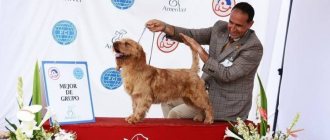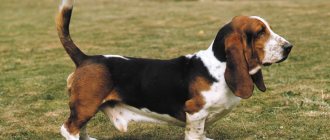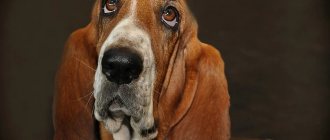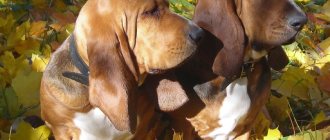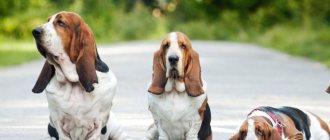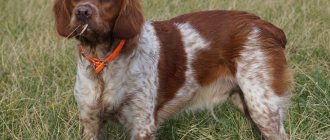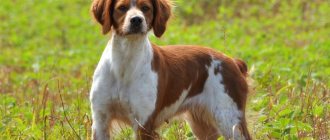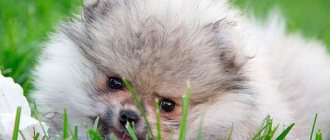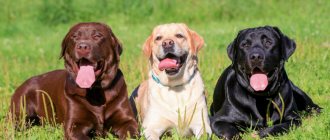The Breton Basset (French Basset Fauve de Bretagne - red Breton Basset, French hound) is a medium-sized hound breed of hunting dog bred in France. Used for hunting hare, fox, wild boar and small game. Friendly to people, strongly attached to the owner. Ideal as a family dog as he gets along well with children. This is a cheerful, friendly dog, but in some cases it can be stubborn. Breton Basset Hounds have good health, high mobility and curiosity.
Description of the Basset Hound breed
Popularity 162nd among 263 dog breeds
Lifespan:
10-12 years
Breed group:
Hounds
Height:
33-38 cm
Country of origin:
France, UK
Average price:
25-35 thousand rubles
Weight:
18-29 kg
Latest articles Cat health
Rabies vaccination for cats: choice of vaccine, necessity, schedule 01/22/2022 4 0 0
Selection and adaptation
TOP 20 best cat breeds for families with children 01/22/2022 25 0 0
Applicability and specialization of the red Breton Basset
Previously, the breed was used to hunt wild rabbits, now - hare, badger and fox. The dogs work in a pack of 4-6 individuals. In pursuit of game, small red basset dogs develop tremendous speed. As mentioned earlier, the external features of the breed make the dogs very “passable” in almost any conditions.
Due to their cheerful and friendly disposition, Bretons do well as family dogs. One of the advantages of this specialization is their excellent compatibility with children.
The French Hound is an excellent companion dog. She will be happy to spend time with her owner in any situation, supporting his hobbies. Travel please! Bretons are hardy and inquisitive. Sport? Easily! The high need for mobility and playfulness of these dogs will ensure athletic achievements. Evening walks in the park? To your joy!
The Bretons' security qualities are not very well developed, but the dog will definitely warn you of danger with a loud bark. Bassets love to bark, which can undoubtedly scare away those who prefer a calm environment. But since dogs were bred to chase and search for prey, the desire to bark is genetic. At the same time, they have a rather sonorous voice.
Key facts
According to the characteristics of the breed, the Basset Hound is a hound, has very short legs, good adaptability to terrain, and has an excellent sense of smell. The folds above the eyes give the impression of a perpetually sad mood, but the breed is very cheerful and has great intelligence and loyalty. The male and female are of a fairly muscular build; the size of the Basset Hound is without strong gender differences: the difference in weight rarely reaches 2 kg.
Excellent hunters, devoted companions for their owner, basset dogs require a lot of attention. As a reward, the owner will receive loyalty and the opportunity to watch a real English gentleman every day. Short legs and a good sense of smell made them excellent burrow hunters.
In their homeland, basset dogs are called “couch athletes” due to their powerful, muscular body and desire to lounge on furniture. Periods of activity are replaced by a desire to be a little lazy. Remember: the hunting instinct is not forgotten even in indoor dogs; on the street it will be difficult to distract a dog that is “on the trail.”
The Basset needs a lot of walking, just like any hound. Don't be fooled by its homely appearance - you'll have to spend a lot of time outdoors.
The Basset Hound has a deep and bright voice, and your neighbors will witness this when the dog is left at home alone. Take care not to leave your dog alone for long periods of time.
The description of the Basset Hound breed includes one distinctive feature: extremely high intelligence, and some experts call the Basset Hound one of the smartest dogs.
A long body, a good sense of smell, short legs - all this made the dogs excellent burrow hunters. With them you can go after a hare, fox, badger.
The health and lifespan of a Basset Hound depends on its care. If a dog is not sick with anything, it can live 12 years or more.
Features of the appearance of the Breton Basset
The Basset Fauve de Bretagne is one of six officially recognized basset breeds, and one of five whose homeland is considered to be only France. The appearance of the red basset is easily recognizable: short stature, short legs, elongated body and wiry type of fur, deer color. The name of the breed itself speaks about the color of the dog. The fur on the belly has a “coat” - elongated hairs.
Hard, dense wool allows them to easily make their way after game through thorny bushes, dense fields, and deep ravines.
Color options:
- Plain: gray, white, fawn with shades of hare, white-gray, beige.
- Two-color: white with black, gray, fawn or red.
- Tri-color: a combination of black, white and fawn.
History of the origin of the Basset Hound
The basset definitely looks like a British dog; the official homeland in all sources is Great Britain, but in fact the country of origin of the basset hound is France. It was there that the breed was first bred. The history of basset dogs begins in the Middle Ages and has quite interesting facts.
Books, manuscripts, and various illustrations from the Middle Ages in France convey notes about short-legged dogs from the Artesian-Norman hounds. In the 17th century, basset dogs were bred en masse in France.
The breed has received a new qualification. Now they went with them to hunt pheasants, and not just burrow animals. Of course, this was a hunt on foot; it was difficult for a basset to keep up with a horse. But the short legs served their purpose. Where a horse or a large hound could not go, the basset always got through. Shrubs, dead wood, and small ravines were within the capabilities of these hobbits from the world of dogs.
While the nobles were hunting, the commoners were not sitting idle. French peasants fell in love with Basset hounds for their excellent sense of smell and used them in search of truffles.
The breed received further development in Great Britain in the 19th century. Bassets were bred with Bloodhounds, and a local flavor was added in the form of very long ears and an elongated body. The real name Basset Hound appeared (“basset” means “low”).
In Russia, the breed began to develop only in the 70s of the 20th century, although it was originally imported under Peter I. The dogs were bought for a fabulous price, kept in the Izmailovo menagerie, but after the death of the reformer they were forgotten about.
History of the breed Red Breton Basset
The birthplace of this breed is France. The breed was specially bred by crossing a Vendean Basset Griffon with a Great Breton Hound (aka the Red Breton Giffon). The main specialization of this dog is hunting; accordingly, when breeding the breed, it was the working qualities of the animals that were considered.
The breed appeared in the 19th century. These dogs became very popular among the noble families of France, Belgium, Holland and Denmark for hunting wild boar and deer, and in the 20th century these dogs became a favorite among the hounds when hunting hares. Cynologists from France, Belgium, and Great Britain are engaged in breeding red Breton Basset Hounds; there are practically no specialized nurseries in other countries.
In Russia, Breton basset dogs began to appear only at the end of the 20th century. Until recently, the breed was considered endangered. But now in France the number of Breton Basset Hounds is gradually but steadily increasing, and other countries are showing more and more interest in these beautiful dogs.
This Basset was bred from the Great Breton Hound and the Vendeen Basset Griffon.
Appearance of a basset hound
General impression
At first glance at a photo of a basset hound, it seems that what you are looking at is rather a lazy, clumsy caterpillar. Short-legged, with long ears, an eternal mournful expression on the face. Many funny pictures of this breed have circulated online. But…
The dog can experience any emotions, anger, joy, fun, fear, but the expression in the eyes will always show severe sorrow. When running, his long ears flutter so much that it seems as if the dog is taking off. It’s hard to imagine him as a hunter, but the short legs help with this – with them the dog becomes well adapted to the uneven terrain.
Head
Large, elongated, clearly protruding back of the head, parallel lines of the muzzle and skull, cheekbones and cheeks do not protrude, overhanging skin forms wrinkles around the eyes and eyebrows.
Neck
Muscular, long, elongated, well defined dewlap.
Torso
A wide back, withers and croup are located on the same line, the body is strong, muscular, elongated in size, harmoniously developed chest.
Forelegs
Short, strong, strong bones, tightly tucked elbows, slight S-curve allowed.
Hind limbs
Strong, powerful, parallel to each other, rounded hips, low hocks.
Tail
Long, strong, with a slight bend, raised upward when moving.
Movement
Rhythmic, free, not fast, hind and forelimbs are coordinated.
Wool
Short, no fringes.
Color
Usually found in two or three colors. All Basset Hound colors are acceptable for non-breeding purposes.
Size
Dogs have a heavy, elongated body. Basset Hound weight: 18-29 kg. Basset Hound height (height at withers): 33-38 cm. Too much height is grounds for disqualification.
Basset Hound Personality
Basset is a real aristocrat from Great Britain, a gentleman with a sad face. All this is appearance, but what is different about the personality of a basset hound?
This hunter is very friendly, active, and sociable. The dog is sociable and does not like loneliness. It feels bad at home without its owners, keep this in mind. Great sadness, sadness on the face is just a mask. The breed is cheerful and happy to make contact. Very smart, but moderately willful. Easy to train, provided the correct approach is taken to this gentleman of blue blood.
Children and other animals fit perfectly into the Basset Hound's life. He can even get along with cats. He lives well in an apartment, but at the same time he walks outside with great pleasure. Natural instincts are not forgotten, so be careful on the street. Once a basset gets caught up in someone's scent, it will be difficult to stop him.
The ideal option for an English hunter would be to live in a country house, where this short-legged dog can get plenty of exercise. Reviews from owners describe that even in winter, basset dogs feel good outside without overalls. All thanks to great activity and high-quality undercoat.
If you get a basset hound, give the dog plenty of attention. At home, he wants contact with the owner, otherwise all the neighbors will hear how loud your dog barks and howls. He does not accept privacy.
The difficulty lies in his stubbornness: when he wants to do something, he will do it, and it will be difficult to convince him. For example, the basset loves to lie on something soft, so rest assured: while you are at work, he will definitely sleep on your bed. A love of sofas and beds is a distinctive feature of the breed.
A basset puppy will charm you with its appearance and long ears, it will be affectionate and active, but an adult dog will be distinguished only by some waywardness. Who is the Basset Hound suitable for? An active person who lives in one place and also has the patience to communicate with a funny stubborn person.
Character and temperament
The Basset Hound's sweet, friendly nature easily makes them a favorite with children and adults.
You cannot remain indifferent to this breed if you come across it at least once - you will fall in love with Basset hounds forever, and they will fall in love with you. The character of this dog is born with a friendly attitude towards people. They become attached not only to the owner, but also to all family members. Basset Hounds were originally bred to hunt in groups with other dogs, so the Breton Basset Hound is a good choice if you already have dogs and want to get more. The only thing worth paying attention to is that, like most working dog breeds, Bretons have a tendency to dominate, i.e. may try to “suppress” other animals in the house, take away food and drive them away from their favorite place, they will fight for the owner’s attention, sometimes in a not entirely “legal” way. But the dominance gene is not clearly expressed in them, and practically does not give rise to sharply aggressive behavior. Usually, after the establishment of a social hierarchy, the basset's desire to infringe on the rights of other animals fades away.
Relationships with other animals (especially smaller ones) can be a little tougher for Basset hounds, as they are hunting dogs. However, such nuances are easily corrected by the early education of the basset.
There is almost a 100% chance that the Breton Basset will have an excellent relationship with children. In addition to their common interests in being ready to play everywhere and always, Bassets are very patient with actions and are ready to forgive a lot. A Breton would rather leave or hide from an ill-mannered child than allow himself to bite or scare him.
Education and training
The question all owners ask. How to raise a dog so that it grows up to be an easy-going four-legged friend? The Basset Hound is an interesting, sociable breed, but at the same time it knows how to stand its ground and protect its interests. Take this feature into account when you begin raising and training your Basset Hound.
Command training should be carried out by a specialist or experienced dog breeder. You don't need to put a lot of pressure on the basset, you just need to find the right approach. Observe your pet, try to understand it.
Yes, he can carry out commands less clearly than a guard dog, constant comments will periodically irritate him. But if the training is organized correctly, the basset can greatly succeed in training.
Successful training cannot happen without a good incentive. Food is an excellent “engine of progress” for the basset hound. Just be careful not to overfeed this smart beggar. Otherwise, he will be very trained and at the same time incredibly fat.
Each exercise and lesson should not exceed 10 minutes, otherwise the dog will get tired. Accustom your basset not only to commands: he must get used to being alone for a while. Leave him alone for an hour at first, then increase the interval.
How to wean a puppy and an adult dog from collecting different things? Yes, he loves it, collecting slippers and various objects in a pile. There is no definitively successful solution to recommend. Keep valuables away as far as possible. If you notice that your pet chews furniture, shoes, or spoils things, try to buy new dog toys that he can chew without restrictions.
How to train a basset hound to go to the toilet regularly? The usual standard method will do: take the puppy outside after feeding. If he came from the street without results, go again after 5 minutes. Basset must understand that the job must be done.
If the floor is covered in puddles despite all your efforts, consider whether there is a place for injustice. The breed is touchy and knows how to do dirty tricks out of spite.
Is it possible to punish a basset hound? No, he shouldn’t, he will only hide in thoughts, then try to take revenge. Be an older friend and teacher; the dog will not want to tolerate a serious supervisor.
What time of year can you train a basset hound outside? In any case, in summer and spring it’s comfortable in any case. In winter, the Basset is not afraid of cold weather due to its thick undercoat. In the fall, especially in the rain, wear overalls. The dog loves to roll in the mud.
Basset Hound Health and Diseases
Possible diseases
Basset Hounds have fairly good health. The breed is very hardy. However, heredity has endowed them with some characteristics, which sometimes result in complex diseases.
If there are alarming signs, you should contact your veterinarian immediately.
This will help prevent serious illnesses. Like all dogs, vaccinations must be carried out on time. Frequent diseases of Basset hounds:
- von Willebrand disease;
- otitis;
- skin diseases;
- eye diseases;
- dysplasia of the hip and elbow joint;
- allergies to food components and plants;
- interdigital cysts;
- intestinal volvulus.
What are these diseases associated with and what treatment is required?
Blood clotting problems, or von Willebrand's disease, are hereditary in Basset Hounds. It must be remembered that any injury has a risk of death. A blood plasma transfusion can help. If the diagnosis is confirmed, the dog is removed from the breeding program.
Often joints in dogs suffer (this is dysplasia). Pathology is poorly detected at an early stage. Only when the dog begins to pay attention to its paws does the owner notice the problem. Full recovery does not occur; the course of the disease can only be successfully stopped.
Due to overhanging folds of the eyelids, the eyes suffer: glaucoma, conjunctivitis, cataracts, and deformation of the eyelids appear. When eye diseases are detected, the breeding work of the dog is called into question.
Obesity is a problem for all Basset Hounds; the breed has a high tendency to be overweight. A proper, balanced diet and active walks will be excellent prevention. A quiet apartment life will definitely add extra weight to your pet.
As the owner of long ears, the dog has to deal with infections more often than others. Clean your pet's ears frequently and diligently.
Difficulty breathing through the nose, sneezing, nosebleeds are obvious symptoms of an inflammatory disease. The most common is rhinitis (runny nose). Most dogs suffer from tartar and other oral diseases, and Basset Hounds are no exception. Check and brush your teeth as often as possible. Let bleeding gums, an unpleasant odor, and caries alert you.
The Basset, like any other dog, must be vaccinated against hepatitis, rabies, trichophytosis, distemper, parainfluenza, and leptospirosis.
Reproductive health
The first heat of a Basset Hound begins at the age of 6-12 months, lasts about 20 days, sometimes up to a month, with a frequency of 7-9 months. The main signs of the onset: the bitch began to often ask to go to the toilet, aggressive, tired, asking to eat and drink more.
Pregnancy can be determined four weeks after mating. Labor begins after 58-65 days. The first birth process for a bitch is very nervous, she does not understand what is happening and what needs to be done, it can damage the puppies. It is recommended to accompany the birth of babies.
Neutering for beagle dogs is usually a controversial issue. The owners are afraid of deterioration in hunting qualities. If you do decide, it is recommended to consult with your veterinarian about the appropriate age for surgery.
Features of feeding and diet
How to feed this funny puppy? The Basset Hound is a fast-growing breed, so the puppies' diet should be nutritious from the first months. You need to decide what the food will consist of, decide what to feed throughout your life.
How many times should you feed your baby? Here it is worth sticking to the standard schedule and taking age into account. At the age of up to 2 months - 6 times, 2-3 months. – 5 times, 4-6 months – 4 times, 6-12 months – 3 times, after 1 year – 2 times.
How much to feed, what serving size is optimal? The dog has a good appetite, but large portions are not needed. All standards can be viewed in the dog breeding table. Think in advance about what the feeding will consist of.
It is advisable to think over a monthly diet (if the dog does not eat dry food). This will make it easier to understand how balanced your dog’s diet is. Is it possible to serve food from a common table? The Basset should not eat confectionery, sausage, fatty meat, legumes, fried foods, potatoes, radishes.
Suitable for daily nutrition:
- beef;
- rabbit;
- turkey;
- rice and buckwheat porridge;
- steamed millet;
- cottage cheese;
- fermented baked milk;
- kefir.
After consulting with your doctor, you can add vitamin and mineral complexes. Fresh drinking water should always be available.
When it comes to drying, which food is right for your dog? You'll have to experiment a little, but experts advise choosing food from more expensive brands. Quality nutrition is the key to good health. Chat with dog breeders on forums, read reviews, it will be easier to choose.
Care and maintenance
Caring for and maintaining a Basset does not require special procedures or expensive purchases; the breed is quite clean. A standard set (bowls, leash, collar, toys) will be enough.
The Basset's coat is short and harsh. Molting is noticeable in autumn and spring. It is better to brush your hair daily: a brush with natural bristles is suitable for this. Washing will save you from the unpleasant odor. Bathe your dog 2 times a month using suitable shampoos.
Due to the folds on its muzzle, the Basset Hound is prone to slobbering. Don't be surprised, you'll have to wipe off the drool often. After walking and feeding, remove saliva with a towel. Bassets also know how to drink water so much that they splash it all over the floor.
How to care for long ears? Remember: the ears are the weak point of the breed; they need to be cleaned, washed, and even ventilated often. This will prevent the occurrence of infections. You can watch the video if you are not sure or are afraid of harming your dog’s ears.
Teeth and oral cavity should be regularly examined and cleaned with a special brush. The dog will resist, but the procedure is necessary. It is better to teach it from puppyhood.
The nails need to be trimmed a couple of times a month, otherwise you will hear the basset hound clattering quite loudly on the floor. Due to drooping eyelids, inflammation in the eyes is likely; do not forget to treat the eyelids with a cotton pad with chamomile infusion. The procedure is simple, but it will avoid the development of an eye infection.
If your dog is participating in a show, wash it two days before the event. Use shampoo with oil. Brush your teeth with a special brush, trim your nails a few days in advance and treat them with a nail file.
Of course, the Basset is not a long-haired dog, he does not need a haircut or endless scratching. But removing fleas and ticks, combing fur during shedding, and treating claws are mandatory.
Brief breed card Fawn Brittany Basset
| Lifespan: | 11-14 years old |
| Origin: | France |
| Applicability: | hunting hound dog, companion, family |
| Size: | a small dog |
| Weight: | 16-18 kg |
| Height: | 30-40 cm |
| Contents in the apartment: | only when providing physical loads |
| The need for physical load: | high |
| Tendency to illness: | low |
| Owner experience: | average |
| Training: | complex |
| Dominance: | there are manifestations of dominant behavior |
| Child Compatibility: | excellent |
| Compatibility with other animals: | good |
| Average price: | 400 euros |
| FCI standard: | No. 36 (link to standard) |
| Shedding: | weak, 2 times a year |
| Hypoallergenic: | No |
The Breton Basset is the closest relative to the red Breton Griffon breed, which is also known as the Great Breton Hound.
Tips for choosing a puppy
How to choose a healthy puppy with a good pedigree? If you are buying a dog for the first time, you will need to consult an experienced specialist.
Visit exhibitions in advance and talk to professional breeders. Contact the breed club, they will advise you on trusted nurseries. Inspect multiple litters at once so you can compare Basset Hound puppies.
Touch the puppy's tail; if there are kinks or bends, this will be considered a serious defect. The paws should be thick and even. Carefully inspect the ears, wax, plugs, and there should be no unpleasant odor. Observe the puppy’s behavior, how active he is, what his appetite is, and whether he is very timid. If you notice deviations, the price of the puppy should be lowered.
